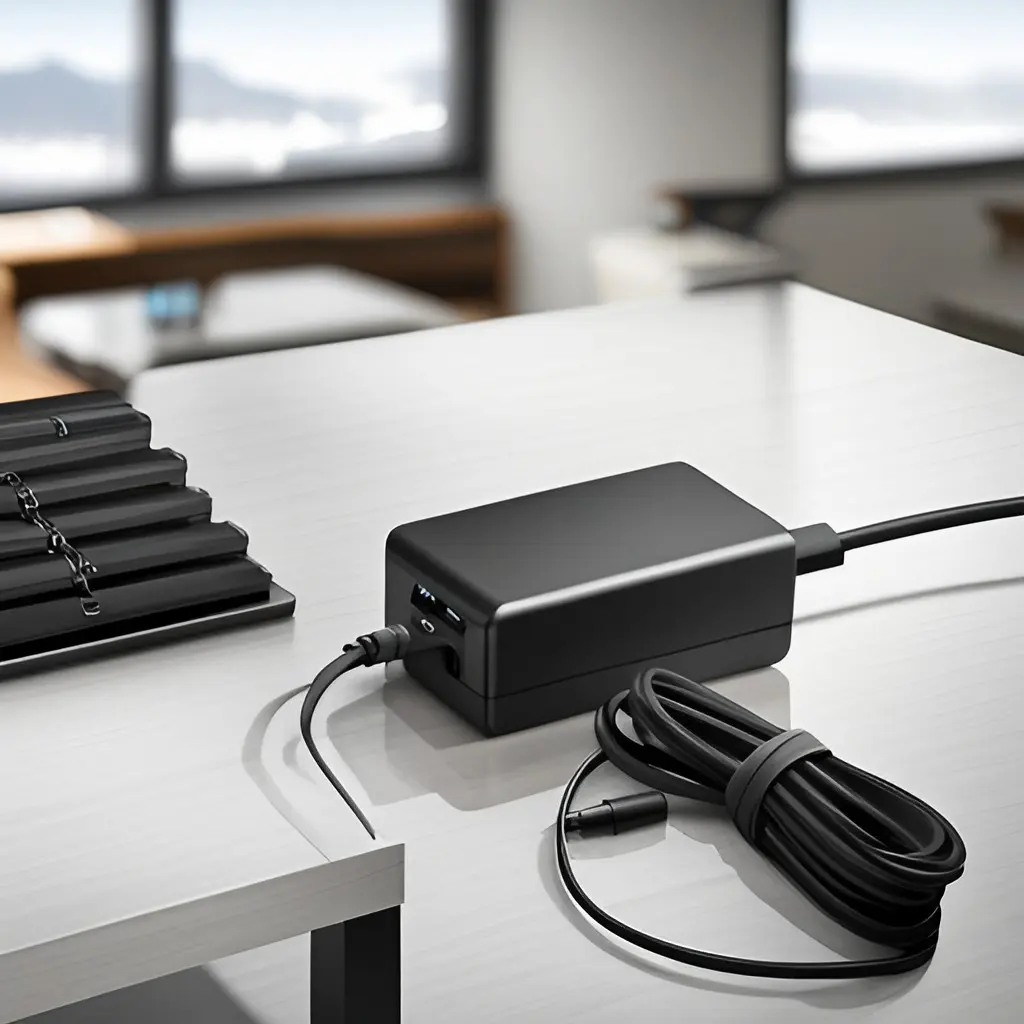As a Dell laptop owner, you may encounter some issues with your device.
One common issue that can be frustrating is when your laptop won’t charge when it’s plugged in. This can be caused by different factors in the power system of the computer.
Whether you’re a novice or a seasoned laptop user, this guide will provide a step-by-step process to help you troubleshoot and fix your Dell laptop.
Understanding Laptop Power Systems
Understanding AC Adapter’s Role in Laptop Charging
Before we delve into the steps to fix your Dell laptop charger, it’s worth understanding how laptop power systems work.
It’s a critical aspect that can make the difference between fixing the issue and causing more problems. Your Dell laptop has three key components that directly affect power usage; the battery, the AC adapter, and the motherboard.
The motherboard controls the flow of power from the AC adapter to the battery, which then distributes power to the laptop. Before anything else, it’s important to ensure that all three components are in the right state.

The AC (Alternating Current) adapter serves as the power source for your laptop when plugged into an electrical outlet. This component is designed to convert the high-voltage AC power from the wall outlet to low-voltage DC (Direct Current) power that your laptop can safely use.
When your laptop is plugged in, the AC adapter supplies power for operating the laptop and charging the battery. If the AC adapter is malfunctioning or not properly connected, it won’t be able to supply power, which could be why your Dell laptop is not charging when plugged in.
The Laptop Battery: Energy Storage System
The battery serves as an energy storage system for your laptop. It stores the DC power supplied by the AC adapter so that the laptop can function without being plugged into an electrical outlet. The battery charges when your laptop is plugged in and power is supplied by the AC adapter.
When you’re using your laptop without AC power, the battery discharges, providing DC power to run the laptop. If your battery is damaged or near the end of its lifespan, it may not be able to charge or hold a charge, even when the AC adapter is supplying power.
Involvement of the Motherboard in Laptop Charging Process
Lastly, the motherboard plays an integral role in charging as it houses the power jack (the port where you plug in the AC adapter) and manages the flow of power to the laptop components, including the battery.
In a properly functioning laptop, when the AC adapter supplies power to the power jack, the motherboard routes this power to the various components and coordinates the charging process. This ensures that the laptop operates efficiently, and the battery charges correctly.
If there is an issue with the motherboard, particularly with the circuits related to power distribution, your laptop may not recognize or use the power supply, and the laptop won’t charge.
Fundamentals of Laptop Power Systems
Understanding the roles of these three components – the AC adapter, the battery, and the motherboard – can help you troubleshoot issues of your Dell laptop not charging when plugged in.
Always ensure that you’re using a functioning AC adapter and that your battery is in good shape. If your laptop still isn’t charging, it might be due to an issue with the motherboard that likely requires professional repair.
Troubleshooting the AC Adapter
Physical Inspection of the AC Adapter
Begin by visually inspecting the AC adapter for any visible signs of damage. This includes looking for any fraying or damage on the adapter’s wire, cracks or damage on the plug or burns on the adapter itself. Even small signs of damage can impact the adapter’s functionality.
Testing the AC Adapter with a Voltmeter
To accurately assess the functioning of your AC adapter, you will require a voltmeter. Before you start testing, ensure your safety by unplugging the AC adapter from both the wall outlet and the laptop.
Set the voltmeter to the DC voltage range and connect the adapter to your laptop. While your adapter is connected, touch the outer conductor of the adapter plug with the voltmeter’s negative (-) lead and the inner conductor of the plug with the positive (+) lead.
The voltmeter should display a reading close to the output voltage specified on your adapter. If the reading is significantly higher or lower, or if there’s no voltage being output at all, the adapter might be faulty.
Checking Laptop Recognition of the AC Adapter
If your voltmeter displays the correct reading but your laptop still isn’t charging, the problem might lie with your laptop’s software. Check if your laptop recognizes the adapter by going to your ‘Battery Settings’ on your laptop.
If the status reads “Plugged in, not charging”, this might mean your laptop is preventing the battery from charging even though it registers the presence of an AC adapter. Updating your BIOS or resetting your laptop’s battery driver could fix this issue.
Troubleshoot Potential Power Outlet Issues
Before concluding that your adapter is the issue, try plugging it into a different power outlet. It’s possible that the outlet you’re using isn’t providing sufficient power or isn’t working properly.
If your laptop charges after switching outlets, then the issue could have been with the original power outlet. If your laptop still won’t charge, then there might be a problem with the adapter or the laptop’s charging port.
Related: Fixing Your Dell Laptop Keyboard: Troubleshooting Tips
Checking the Laptop Battery
Recognizing Battery Degradation and Short-Circuiting
The two common issues that can prevent a Dell laptop from charging are battery degradation and short-circuiting. Battery degradation occurs over time as the chemical reactions within the battery become less efficient.
This means the battery’s capacity to hold a charge diminishes, resulting in the laptop losing power quickly or not charging at all.
Short-circuiting, on the other hand, occurs when there is an unintended path between two points of different electrical potential within the laptop’s battery.
This can result in a sudden loss of battery life or the inability of the laptop to recognize it’s charging when it’s plugged in.
Checking the Battery Health
To check the health of your Dell laptop’s battery, follow these steps:
- Unplug the charger from your laptop.
- Click on the Windows “Start” button (the Windows logo is located at the bottom left of your screen).
- Type “cmd” into the search bar and press “Enter.”
- This will open a command prompt. Type “powercfg /batteryreport” and press “Enter.” Please note that there is a space between “powercfg” and “/batteryreport”.
- Windows will generate a report detailing the health of your laptop’s battery. You’ll see information about the battery life estimates and its capacity history.
Accessing Dell’s Built-In Battery Check in BIOS
To access Dell’s battery diagnostic tool via BIOS, first, you need to shut down your laptop. Once the laptop is completely powered off, turn it on again.
Right away, start pressing the F2 key repeatedly until the BIOS Setup screen appears. In the BIOS setup, navigate using the arrow keys on your keyboard.
Look for a tab labeled “Battery Information” or “Power Management.” Once you’re in the right tab, you will see information about your battery health, charge level, and other relevant details.
- Pay close attention to the “Battery Health” status. If it says “This battery is performing normally,” then your battery is fine.
- If it says “Your battery is able to charge normally. However, you may begin to notice reduced operating time because your long-term battery life is decreasing,” this means your battery is in the process of wearing out and you should plan a replacement soon.
- If it says “Your battery is nearing the end of its usable life,” or “Your battery requires replacement,” you need to replace your battery immediately.
Interpreting the Battery Report
Within the battery report, there are two key points to consider: the ‘Design Capacity’ and the ‘Full Charge Capacity’. ‘Design Capacity’ is the amount of charge that the battery could originally hold when it was fresh out of the factory. ‘Full Charge Capacity’ is the amount of charge the battery can hold now.
If the ‘Full Charge Capacity’ is significantly less than the ‘Design Capacity’, then the battery has undergone significant degradation, meaning it can hold less charge than it was designed to. If this is the case, you may need to replace the battery.
If the ‘Full Charge Capacity’ is equal or close to the ‘Design Capacity’ yet your laptop is not charging when plugged in, this could indicate that the battery has short-circuited. If this happens, it is highly recommended for safety reasons to replace the battery.
Remember, if you’re not confident with checking the battery’s health or replacing it yourself, consider having a professional technician assess and possibly service the laptop for you. Always remember that safety comes first when dealing with electronic components.
Related: Dell Laptop Won’t Turn On | The FIX

Assessing the Charging Port and Motherboard
Inspecting the Charging Port
The first step in diagnosing a Dell laptop that won’t charge when plugged in is to inspect the charging port.
Signs of physical damage may include bent or broken pins, debris or dust inside the port, or visible wear and tear.
To check for these signs, you can shine a flashlight into the port to get a better view. Be sure to look at the port from multiple angles. If you see any physical problems, these could be the culprit. However, if the port appears to be in good physical condition, the issue may lie elsewhere.
It’s also worth examining the power cord and the adapter itself. Look for any breakages, worn-out pieces, or burn marks. These can also suggest a problem with the physical connection.
Diagnosing Motherboard Issues
Motherboard issues may also cause charging problems. If your Dell laptop only charges intermittently or the charging indicator flickers, this could indicate a motherboard problem.
One key sign of motherboard issues is erratic or non-standard behavior – for example, if the laptop turns on without being plugged in, but turns off immediately after being unplugged.
If your device experiences other common symptoms of a failing motherboard like freezing, crashing, or failure to boot up then these issues may be linked to your charging problem.
System Diagnosis
Your Dell laptop comes with tools for diagnosing system issues, including a power adapter test. Press F12 during startup to access the Boot Menu and then select ‘Diagnostics’.
Go through the diagnostic steps to test the power adapter. If the test fails, it confirms the issue with the power adapter; if it passes, the issue might be related to the motherboard.
When to Seek Professional Help
While these steps can help you understand whether the issue lies with the charging port, power adapter, or motherboard, some problems require professional assistance. If you are uncomfortable opening your laptop, or if the diagnostic tools suggest more advanced hardware issues, it might be time to seek professional help.
Dell’s customer support is a helpful resource, offering both online and phone assistance. Alternatively, you could take your laptop to a local computer repair shop. They may be able to better assess whether the charging problem is due to a faulty battery, a damaged charging port, or a malfunctioning motherboard.
Remember, trying to examine or fix these parts yourself without the necessary knowledge and tools can lead to more damage, so when in doubt, please consult a professional.
Conclusion:
Dell laptops are widely used globally, and they have proven to be reliable over the years. However, like any other device, they can experience problems, like not charging when plugged in. In this blog, we’ve highlighted the steps to troubleshoot and fix this issue. By understanding your laptop’s power system, and checking the AC adapter, battery, battery report, charging port, and motherboard, you can solve the problem and avoid any costly repair bills.

J.S. is the owner, content creator, and editor at Upgrades-and-Options.com. I’ve worked in the IT and Computer Support field for over 20 years. The server hardware in my computer labs has mostly been IBM, but I’ve supported Dell, HP, and various other hardware. In addition, as part of my lab administrator responsibilities, I’ve learned, supported, and repaired/upgraded network hardware such as Cisco routers and switches. READ FULL BIO >>
- How to Replace Your Laptop Battery: A Step-by-Step Guide
- Shut Down a Lenovo Laptop: Quick and Easy
- Why Is My Computer So Slow? Ways to Fix It Now!
- Connecting Your AirPods to Your Windows Laptop
- How to Easily Update Realtek 802.11 N WLAN Adapter Drivers for Seamless Connectivity
- How to Troubleshoot a Black Screen on Lenovo Legion 5 15ACH6H
- Lenovo Laptop Freezing – How To Fix
- SSD Not Showing Up In Bios Or Windows | Easy Fix


